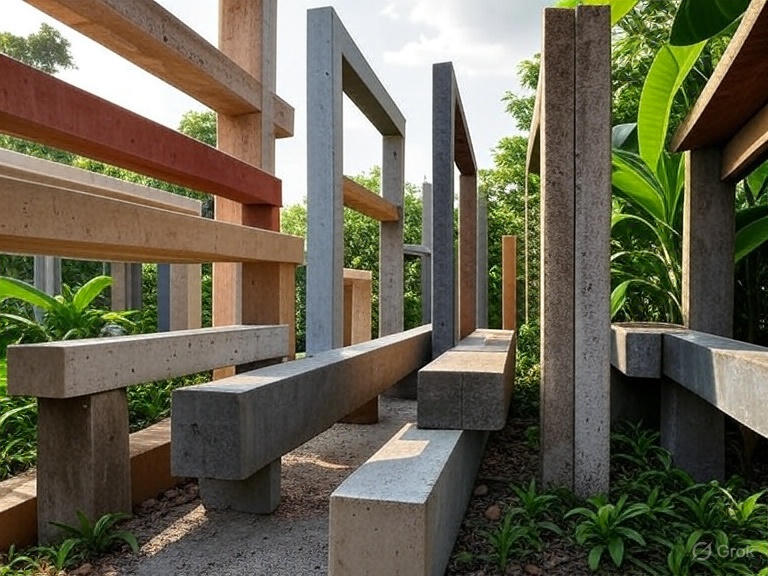
October 01, 2025 - Zed van der Vyver
Introduction to Beams in Thailand
Beams are fundamental structural elements in any building in Thailand, providing support and stability in a country prone to heavy monsoons, earthquakes, and high humidity. They’re the hidden framework that holds up roofs, floors, and walls. This blog will explain why beams are essential in Thailand, the different types for various needs, how they’re made, and what they might cost. No engineering background required—just straightforward info to help you understand this key part of construction!
Why Beams Are Essential in Thailand
Beams transfer loads from roofs and floors to columns or walls, preventing sagging or collapse. In Thailand, where monsoons bring intense rain and wind in areas like Ayutthaya or Phuket, beams must withstand moisture and flooding. They also provide earthquake resistance in regions like Chiang Mai. Beams allow for open spaces in modern designs and support traditional elevated homes that avoid floods. Without strong beams, buildings could fail under Thailand’s environmental stresses, making them crucial for safety and longevity.
Types of Beams for Different Scenarios in Thailand
Beams vary by material and design, and the right type depends on your building and location. Here’s a look at common types in Thailand and where they fit best:
Concrete Beams
Use: Multi-story buildings or flood zones.
Why: Reinforced with steel, they’re strong and water-resistant, ideal for humid climates.
Example Scenario: A condo in Nonthaburi.
Steel Beams
Use: Commercial or modern homes.
Why: Lightweight and high-strength, they span long distances and resist corrosion if coated.
Example Scenario: A factory in Chonburi.
Wooden Beams
Use: Traditional or rural homes.
Why: Made from teak, they’re natural and flexible but need treatment for humidity.
Example Scenario: A village house in Chiang Rai.
Composite Beams
Use: Hybrid or seismic areas.
Why: Combine steel and concrete for strength and cost-efficiency, common in earthquake-prone zones.
Example Scenario: A resort in Phuket.
Your choice depends on load requirements, climate exposure, and design. Thai standards (TIS) ensure beams meet local safety codes.
How Beams Are Made in Thailand
Beams in Thailand are manufactured to handle tropical conditions while meeting structural demands. Here’s a general overview of the process:
- Design: Engineers calculate size and strength based on load and location, considering monsoons or earthquakes.
- Material Prep: Concrete is mixed with cement, sand, and rebar. Steel is rolled into I-shapes. Wood is cut from teak logs.
- Fabrication: Concrete beams are cast in molds with rebar for reinforcement. Steel is welded or bolted. Wood is treated with preservatives.
- Testing: Beams are load-tested for strength, crucial for Thailand’s variable weather.
- Finishing: Concrete cures for weeks. Steel is coated against rust, and wood is varnished for moisture resistance.
Local factories in Bangkok produce concrete and steel beams, while wooden beams are often crafted in northern workshops.
Cost Comparison of Beams in Thailand
Beam costs in Thailand vary by material, size, and span. Here’s a breakdown (in Thai Baht per meter, as of October 2025):
| Beam Type | Cost (THB per meter) | Typical Span | Notes |
|---|---|---|---|
| Concrete Beams | 1,000–3,000 | 3–6 m | Rebar adds cost; durable in wet areas. |
| Steel Beams | 2,000–5,000 | 4–10 m | High strength; coating for rust protection. |
| Wooden Beams | 800–2,500 | 2–5 m | Teak is premium; treatment required. |
| Composite Beams | 1,500–4,000 | 4–8 m | Hybrid efficiency; installation adds expense. |
Example Calculation: A 5-meter concrete beam might cost 5,000–15,000 THB, while steel for the same length could be 10,000–25,000 THB. Installation adds 500–1,500 THB per beam, higher in cities like Pattaya. Prices are up 10–15% since 2020 due to material costs.
Final Thoughts
Beams in Thailand provide the structural support needed to withstand the tropical climate’s challenges. Whether concrete for a sturdy condo or teak for a traditional house, there’s a type for every need. Consider your load requirements, environmental factors, and budget, and consult local engineers for compliance. Strong beams are the unseen strength of a safe home. Got questions? Leave a comment—we’re here to help!
